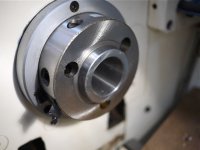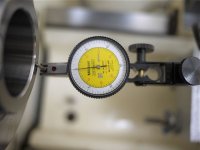Things whent terribly wrong for me during turning some brass.
I had chucked up on a sollid 40mm rod of brass-held by the chucks jaws.
The plan was to do some light cuts to trim it down to go through the headstock.
Long story - short; I did not use my tailstock (with center drilled hole) and using a ultra sharp incert - the brass rod got pulled in to my tool holder and jamed the whole thing, smacking my 650kg lathe in to the air, belt on motor spin, broke a part of the backing plate for the incert and scared the living $hit out of me.
Scared me so much that I was not to happy to go near it again and had me wondering if some of this "cats lifes" had been ticked off.
Anyway-lesson learned - idiotic error so don't turn the knife :embarrassed2:
Here is the problem;
I immediately meassured TIR and at first it looked ok (1month ago). I did a shaft this evening and thought I should recheck again and I'm out by a lot.
Now, I hope this is chuck related- where the jaws is now fairly loose in the chuck- well not loose but there is some fair play in them.
So reboring these is a no go.
Now the machine use the Cam lock D4 setup and I have never played with this setup.
Is there anything which might be damaged in the back plates studs or should I only
try to re-tighten the D4 locking screws?
Or should I try to take everything appart and follow up with my dial indicator
to see where the damage is done?
Hope the bearings made it :embarrassed2:
I guess it might be time now for that 6jaw Bison I dreamed about when I bought the machine :sorry:
I have never taken these things appart but I'm sure I'll figure it out but any feedback from you who have done would be highly appreciated.
Thanks
K
I had chucked up on a sollid 40mm rod of brass-held by the chucks jaws.
The plan was to do some light cuts to trim it down to go through the headstock.
Long story - short; I did not use my tailstock (with center drilled hole) and using a ultra sharp incert - the brass rod got pulled in to my tool holder and jamed the whole thing, smacking my 650kg lathe in to the air, belt on motor spin, broke a part of the backing plate for the incert and scared the living $hit out of me.
Scared me so much that I was not to happy to go near it again and had me wondering if some of this "cats lifes" had been ticked off.
Anyway-lesson learned - idiotic error so don't turn the knife :embarrassed2:
Here is the problem;
I immediately meassured TIR and at first it looked ok (1month ago). I did a shaft this evening and thought I should recheck again and I'm out by a lot.
Now, I hope this is chuck related- where the jaws is now fairly loose in the chuck- well not loose but there is some fair play in them.
So reboring these is a no go.
Now the machine use the Cam lock D4 setup and I have never played with this setup.
Is there anything which might be damaged in the back plates studs or should I only
try to re-tighten the D4 locking screws?
Or should I try to take everything appart and follow up with my dial indicator
to see where the damage is done?
Hope the bearings made it :embarrassed2:
I guess it might be time now for that 6jaw Bison I dreamed about when I bought the machine :sorry:
I have never taken these things appart but I'm sure I'll figure it out but any feedback from you who have done would be highly appreciated.
Thanks
K










